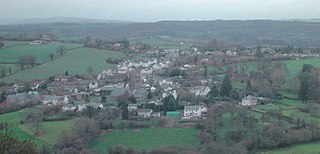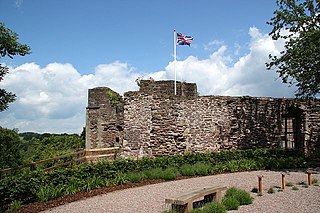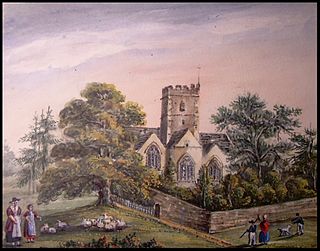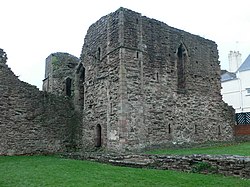
Monmouth is a market town and community in Monmouthshire, Wales, situated on where the River Monnow joins the River Wye, two miles from the Wales–England border. The population in the 2011 census was 10,508, rising from 8,877 in 2001. Monmouth was the county town of historic Monmouthshire, although Abergavenny is the largest settlement and Monmouthshire County Council has its main offices at Rhadyr, just outside Usk. Monmouth is in the Monmouth UK Parliament and Senedd constituencies.

William Marshal, 1st Earl of Pembroke, also called William the Marshal, was an Anglo-Norman soldier and statesman. He served five English kings: Henry II and his son and de jure co-ruler Young King Henry, Richard I, John, and finally John's son Henry III.

Monmouthshire is a county in the south east of Wales. It borders Powys to the north; the English counties of Herefordshire and Gloucestershire to the north and east; the Severn Estuary to the south, and Torfaen, Newport and Blaenau Gwent to the west. The largest town is Abergavenny, and the administrative centre is Usk.
Peter de Rivaux or Peter de Rivallis was an influential Poitevin courtier at the court of Henry III of England. He was related to Peter des Roches, being a nephew.

Richard Marshal, 3rd Earl of Pembroke, was the son of William Marshal, 1st Earl of Pembroke and brother of William Marshal, 2nd Earl of Pembroke, whom he succeeded to the Earldom of Pembroke and Lord Marshal of England upon his brother's death on 6 April 1231.

Grosmont is a village and community near Abergavenny in Monmouthshire, Wales. The population taken at the 2011 census was 920. The wider community (parish) includes the villages of Llangattock Lingoed, Llangua and Llanvetherine.

Grosmont Castle is a ruined castle in the village of Grosmont, Monmouthshire, Wales. The fortification was established by the Normans in the wake of the invasion of England in 1066, to protect the route from Wales to Hereford. Possibly commissioned by William fitz Osbern, the Earl of Hereford, it was originally an earthwork design with timber defences. In 1135, a major Welsh revolt took place, and in response King Stephen brought together Grosmont Castle and its sister fortifications of Skenfrith and White Castle to form a lordship known as the "Three Castles", which continued to play a role in defending the region from Welsh attack for several centuries.

Gilbert Marshal, 4th Earl of Pembroke was the third son of William Marshal, 1st Earl of Pembroke and Countess Isabel, the daughter of Richard son of Gilbert, earl of Striguil. He was a member of the Marshal family.
This article is about the particular significance of the century 1201–1300 to Wales and its people.
This article is about the particular significance of the century 1101–1200 to Wales and its people.
Events from the 1230s in England.

Monmouth Castle is a castle close to the centre of the town of Monmouth, the county town of Monmouthshire, on a hill above the River Monnow in south-east Wales.

The Battle of the Curragh was fought on 1 April 1234 on the Curragh plain in County Kildare, Ireland. The adversaries were men loyal to King Henry III of England on one side, and on the other side Richard Marshal, Earl of Pembroke and Lord of Leinster, who lost the battle and later died from the wounds he suffered. The battle was a small affair in the number of knights involved, but was still significant because it ended the career of the popular Richard Marshal.

Gwladys ferch Dafydd Gam was a Welsh noblewoman. She was the daughter of Dafydd ap Llewelyn ap Hywel, otherwise known as Dafydd Gam, who was killed at the Battle of Agincourt in 1415.
Gilbert Basset was an English baronial leader during the reign of King Henry III.
John of Monmouth was an Anglo-Norman feudal lord of Breton ancestry, who was lord of Monmouth between 1190 and 1248. He was a favourite of both King John and his son, Henry III, and one of the most powerful royal allies in the Welsh Marches.

Baldwin III, Count of Guînes (1198–1244) was a Flemish nobleman. He inherited the war-torn County of Guînes, now in northern France, while Philip II of France was still on the throne and suffered the repercussions of Philip's expansion of the French state. He is now best known as a mercenary leader in the Welsh Marches, employed by Henry III of England in 1233–1234; the family connections with properties held in England was longstanding.
John Devereux of Bodenham and Decies was an Anglo-Norman nobleman living during the reigns of King John and Henry III of England. The Devereux were a prominent knightly family along the Welsh Marches during the thirteenth century, and John Devereux was a key member of the retinue of Richard Marshal, 3rd Earl of Pembroke, and companion of Walter III de Clifford, Baron of Clifford.

Richard Siward was a distinguished 13th-century soldier, adventurer and banneret. He rose from obscurity to become a member of King Henry III's Royal Council and husband of Philippa Basset, the widowed countess of Warwick.
The Three Castles was a former medieval lordship, comprising the fortifications of Grosmont, Skenfrith and White Castle in Monmouthshire, Wales. The castles were established by the Normans in the wake of their conquest of England in 1066, to protect the route from Wales to Hereford. Possibly commissioned by William fitz Osbern, the Earl of Hereford, they initially comprised earthwork fortifications with timber defences. In 1135, a major Welsh revolt took place and in response King Stephen brought the castles together to form the lordship, which continued to play a role in defending the region for several centuries.












